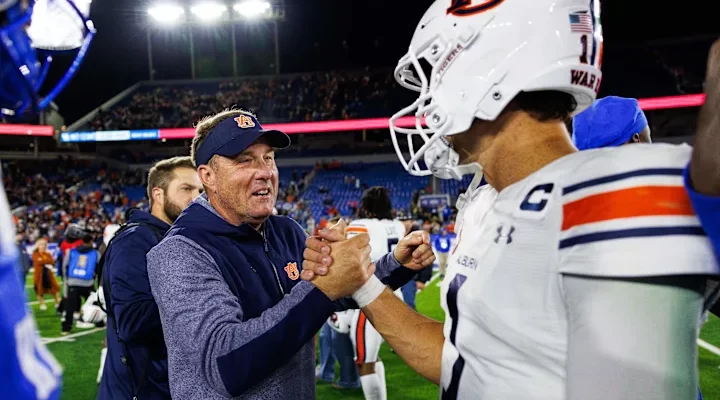Auburn and Coach Freeze Face Crucial Decisions on Roster Retainment and Talent Acquisition as New Revenue Share Model Kicks In
As Auburn University’s football program navigates the dawn of a new era in college athletics, head coach Hugh Freeze and his staff are confronting complex decisions around roster retainment and talent acquisition amid the rollout of a groundbreaking revenue share model. The landscape of college football continues to evolve at a breakneck pace, driven by changes in name, image, and likeness (NIL) policies, the transfer portal’s growing influence, and now, a revenue distribution agreement that promises to reshape the financial dynamics of programs across the nation. For Auburn, a storied program with lofty expectations, this new financial model presents both opportunities and challenges as the Tigers look to solidify their roster, attract top-tier talent, and ultimately return to contention in the fiercely competitive Southeastern Conference (SEC).
At the core of Auburn’s current strategy is the delicate balance between retaining key contributors and bringing in new prospects who can elevate the team’s overall talent level. Coach Hugh Freeze, who returned to Auburn in 2023 with a mandate to rebuild and revitalize the program, understands that roster management in the modern college football era requires a multifaceted approach. The days of simply recruiting the best high school prospects and hoping they develop in-house are long gone. Today, successful programs must master the art of both retention—keeping talented players who might otherwise enter the transfer portal—and acquisition—landing high-impact freshmen and transfers who can make immediate contributions.
The introduction of the new revenue share model adds another layer of complexity. The agreement, which pools a percentage of conference and media revenues to be distributed among member institutions, aims to create more financial parity and stability across programs. For Auburn, this means additional resources that can be invested in recruiting infrastructure, facilities, coaching staff expansion, and player support services. However, with more money flowing into the program, expectations also increase. Fans, boosters, and university administrators alike are demanding a return on investment in the form of wins, high-profile recruits, and deep postseason runs.
One of the immediate impacts of the revenue share model is the increased competition in the transfer portal. Auburn’s front office and coaching staff recognize that the transfer market is a vital source of talent acquisition, especially in an environment where players have greater freedom to move between programs. Coach Freeze has emphasized a proactive approach, targeting transfers who fit the team’s culture and can fill critical needs. The portal offers a unique opportunity to address roster gaps quickly, but it also carries risks—such as disrupting team chemistry or relying too heavily on experienced players who might have fit issues.
Roster retainment, on the other hand, requires a different set of tools. With NIL deals now a significant factor in player decisions, Auburn is working closely with its athletic department and external marketing partners to provide competitive opportunities for players to monetize their personal brands. Ensuring that current players feel valued and supported both on and off the field is paramount to reducing transfer rates. The coaching staff has ramped up communication efforts, involving players in planning and ensuring they understand the long-term vision of the program. This player-centric approach aims to foster loyalty and buy-in, which are critical in a time when transfer portals offer easy exits.
Auburn’s recruiting philosophy under Coach Freeze reflects this dual focus. The staff is known for its meticulous evaluation process, blending traditional scouting with advanced analytics and personality assessments. The goal is to find players who not only have the physical tools but also align with Auburn’s culture of toughness, discipline, and competitiveness. This alignment is essential to minimize the risk of transfers and maximize player development. With the additional financial resources provided by the revenue share model, Auburn is expanding its recruiting footprint to compete more aggressively in talent-rich states beyond its traditional Southeastern recruiting hotbeds.
The schedule for Auburn’s upcoming recruiting cycles already reflects this intensified effort. Early indications show a surge in official visits and campus tours, with coaching staff members dedicating more time than ever to relationship-building activities. While securing blue-chip high school recruits remains a priority, the staff is also doubling down on relationships with junior college programs and potential transfers. This comprehensive approach aims to create a pipeline of talent that can sustain Auburn’s competitiveness over multiple seasons.
However, challenges remain. The SEC is arguably the most competitive conference in college football, and Auburn’s rivals are investing heavily in recruiting and player development. Programs like Alabama, Georgia, and LSU are setting high standards both on and off the field, making Auburn’s task more daunting. Additionally, the increased emphasis on NIL opportunities means Auburn must compete not only with other schools but also with external marketplaces where players can monetize their brands. This evolving dynamic requires Auburn’s staff to be innovative and flexible in their approach to roster management.
In terms of roster composition, Auburn is focusing on balancing experienced upperclassmen with promising underclassmen. The new revenue allows for greater investment in player development programs, including strength and conditioning, nutrition, and mental health resources. These investments aim to reduce injury rates, improve on-field performance, and enhance player satisfaction—all factors that contribute to higher retention rates. The program’s medical and training staff have reported increased collaboration with the coaching staff, ensuring that player wellness remains a top priority.
Another significant aspect of the new model’s impact on Auburn is the ability to offer competitive scholarships and support packages. While the NCAA limits the number of scholarships a program can offer, the additional revenue enables Auburn to provide more comprehensive support, including academic assistance, housing stipends, and enhanced training facilities. This holistic approach to player welfare is designed to make Auburn an attractive destination for top talent, further aiding in both recruitment and retention.
Coach Freeze’s leadership style plays a critical role in this period of transition. Known for his motivational approach and emphasis on accountability, Freeze has been transparent with players about the challenges and opportunities ahead. His communication strategy includes regular team meetings, one-on-one discussions, and an open-door policy that encourages players to voice concerns and ideas. This openness aims to build trust and unity within the roster, essential elements in a program that is rebuilding.
The fanbase, too, is closely watching how Auburn manages this new era. Enthusiasm for the program remains high, but patience is limited. The combination of increased revenue and changing roster dynamics has raised expectations. Fans expect that the financial boost will translate into tangible improvements on the field—more wins, exciting playmakers, and a return to SEC championship contention. The pressure to perform is palpable, and the coaching staff is keenly aware that roster decisions made now will shape the program’s trajectory for years.
Moreover, the administration’s support is strong but measured. University leadership has expressed optimism about the new revenue share system but emphasizes that strategic planning and prudent resource management are crucial. Auburn’s athletic director has publicly endorsed Coach Freeze’s approach, highlighting the importance of balancing immediate roster needs with long-term sustainability. This support provides stability but also underscores the high stakes involved in roster decisions.
Looking ahead, Auburn’s approach to roster retainment and talent acquisition under the new revenue share model will be closely studied as a case example of adapting to modern college football realities. The program’s success or failure in this endeavor will likely influence how other programs balance financial opportunities with competitive necessities. For Auburn, the path forward involves navigating a rapidly changing landscape while honoring the tradition and passion that have defined the Tigers for decades.
In conclusion, Auburn and Coach Hugh Freeze face a pivotal moment in program history. The integration of a new revenue share model brings promise but demands thoughtful action in managing the roster and recruiting pipeline. The challenge is to convert increased resources into sustained success by retaining top players, attracting elite talent, and building a culture of excellence. As the 2025 season approaches, all eyes will be on Auburn’s roster moves and recruiting outcomes. The decisions made now will resonate far beyond the current season, shaping the program’s identity and competitiveness for years to come. With careful planning, strategic investment, and committed leadership, Auburn aims to rise once again as a powerhouse in college football’s ever-evolving landscape.



